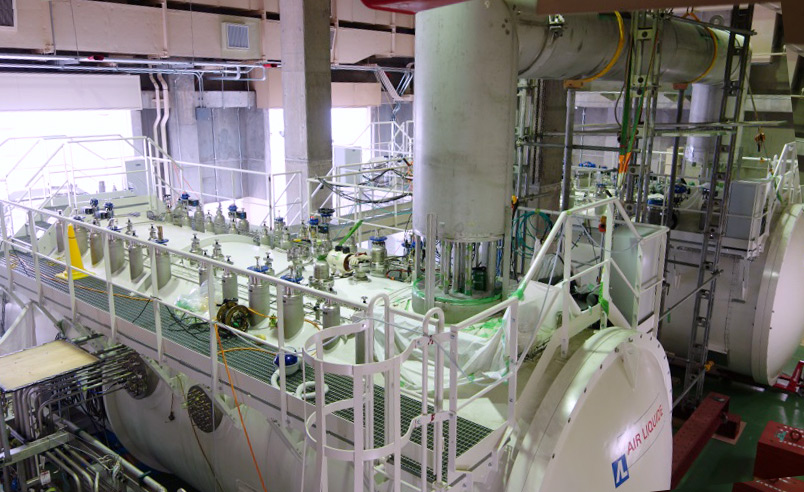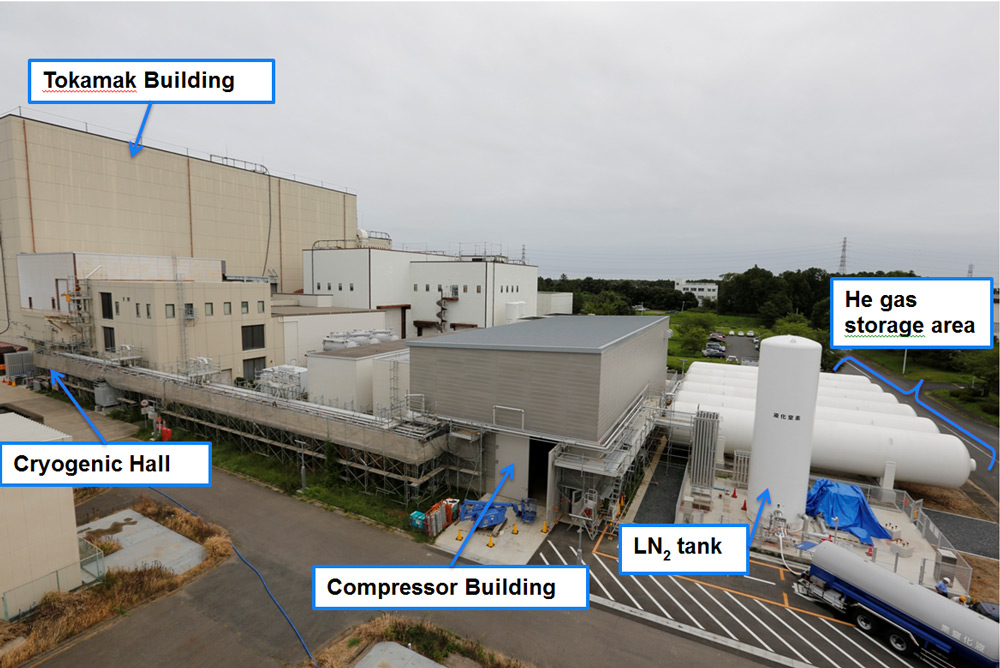JT-60SA cryogenic system installation finished according to tight schedule


The cryogenic system of JT-60SA tokamak installation has been successfully completed, on schedule within the tight schedule of six months from delivery. The system, which will be the most advanced of the three largest helium refrigerators in Asia can be described as a large plant for cooling helium to very low temperatures with an equivalent refrigeration capacity of 9 kW at 4.5 K (-269 degrees C). It will be used to cool the superconducting magnets, cold structures, thermal shields, current leads and divertor cryopumps of JT-60SA.
This cryogenic system is one of the European in-kind contributions to the JT-60SA project (one of the three large projects covered by the Broader Approach agreement concluded between the European Atomic Energy Community (Euratom) and Japan), voluntarily contributed by France. F4E, in collaboration with CEA (Commissariat à l’énergie atomique et aux énergies alternatives), the designated French contributor, developed the preliminary design and specifications of the JT-60SA cryogenic system, with a careful analyses of costs and optimisation of requirements. CEA contracted, in November 2013, the detailed design, manufacturing, installation and commissioning of this system to Air Liquide Advanced Technology (AL-AT) in Sassenage (France). The contract comprises various heavy-weighting components, most of which have been manufactured in Europe and therefore need to be transported to Naka, Japan – the location of where JT-60SA is being constructed. F4E contributed also to hardware, with the supply of the gaseous helium storage vessels.
“The fact that the demanding installation of this complex system has succeeded is indeed a very good example of what can be achieved by joint effort in the Broader Approach projects between Europe and Japan”, says René Gondé, the French Project Director within the European Home Team of JT-60SA.
Japanese Atomic Energy Agency (JAEA), the Japanese Implementing Agency for Broader Approach activities, has finalised construction of a new compressor building, refurbishment of the cryogenic hall, preparation of the foundation for the helium storage vessels, and installation of the high voltage transformers and water cooling towers. Upon arrival, the main components of the cryogenic system from Europe – the large refrigeration cold box (RCB) which is used to cool the helium and the auxiliary cold box (ACB) which will distribute and control helium flows –were immediately moved to their final destination in the cryogenic hall.
Each measuring about 12 x 3.6 x 3.6 metres, and weighing around 70 tonnes, the installation of the RCB and ACB cold boxes has been extremely challenging: their positioning should not deviate more than a few millimetres so that a vacuum and superinsulated cryogenic transfer line which measures 900 mm in diameter and is 8.5 metres long, can be installed between them. Transport from Europe to Japan required complying with major traffic and safety regulations, and once delivered on site, a 550 tonne mobile crane was needed in order to move the gaseous storage vessel. The installation of the cryogenic system has been able to progress impressively quickly thanks to AL-AT’s modular design: most of the subsystems and valve panels were delivered as prefabricated units – only the interconnecting pipes and wiring, and their supports, had to be fabricated and installed on-site by local subcontractors. Nevertheless, about 1,000 metres of piping has had to be installed on site using some 1,350 welds. After installation, all pipes were pressure tested and carefully checked for helium leaks. Once the electrical wiring and the process control system were connected, pressures, temperatures and flow rates have been monitored and the checkout of all instrumentation was performed.


Installation of the cryogenic system within the tight schedule of six months was possible due to the well-coordinated actions and written procedures, careful preparation and control of all interfaces, and the good team spirit between the involved colleagues from F4E, JAEA, CEA, AL-AT and AL-EJ (Air Liquide Engineering Japan). Most of the problems which emerged could be solved fast and without bureaucracy. However, despite the fast progress, safety and quality aspects have always had priority. All actions and areas have always been carefully and regularly checked and reported on by AL-EJ´s safety officer and it has been paramount that all involved workers have been well-protected.
Each unit of the cryogenic system will successively be started up during the next coming months. Already, compressor capacity testing has been successfully carried out, allowing for the eight compressor units (the “motor” of the system) to operate at full capacity continuously for 48 hours. The final Factory Acceptance Tests of the complete plant will be concluded by August 2016.